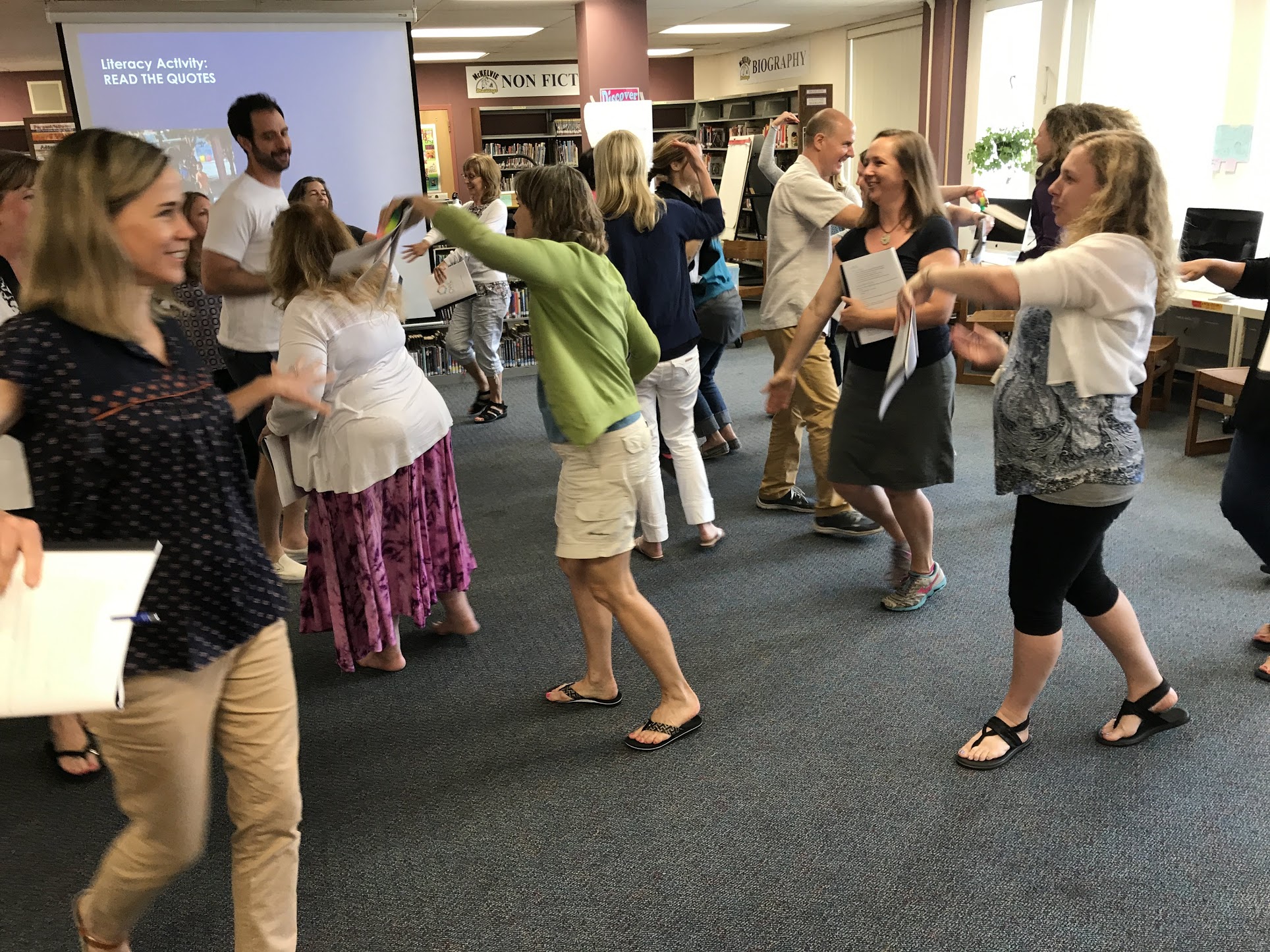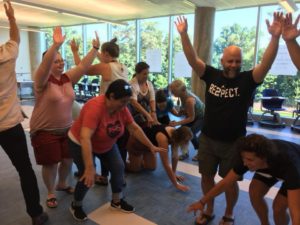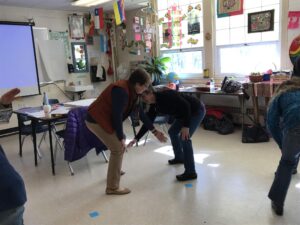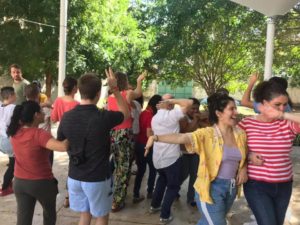
An OWL classroom is immediately identifiable owing to the joy that leaks from the room! Upon entering, one often sees a circle in which fun, games, and chaos are indisputable. The students are in near-constant motion as they play and engage with everyone in class! One of the essential pieces in all of this activity and fun are transitions. What is a transition, you ask? Well, transitions are a kinesthetic element happening in the learning space. They are visible, physical changes initiated in order to reset and refocus, in an entertaining, often comical way. Transitions can also be used to prompt different groupings of students allowing for more social interaction in the classroom. Need some ideas? Great! We’ve got them A-Z for ya! ?
 Arrange yourselves in order of….
Arrange yourselves in order of….
These are really fun to do as it gets the kids talking and finding out information about one another. You can arrange based on birthday month, tallest to shortest, you could use playing cards and have them get in order least to greatest without saying what’s on the card. The possibilities are endless!
Back to back with a partner
Back to back allows me to separate the kids that always want to work together. Once students are back to back, the person who they are facing in the circle is their new friend.
Cross the circle…
Cross the circle lets kids experiment with a new vocabulary that has come up in class. Maybe they cross doing the action of the new concept, cross the circle thinking about what the word means, or cross the circle asking other classmates questions using the term.
Do-si-do your partner
Students shake hands and say thank you to one another (always make time for gratitude!). Holding hands they then pass their partner off to the next person in the circle. You can keep going around the circle as many times as you want!
E.T. phone home!
Students close their eyes and point at someone in the circle. When they open their eyes, they try to connect with the person they were pointing at. Once everyone knows who their new friend is, while pointing at one another they reconnect across the circle like E.T. and Elliott.
Four Corners
Create four options based on student interest and conversation in the classroom. Each corner in your room is one of the options. Students self select the corner that they go to.
Get into groups based on…
This allows you to see student similarities and differences based on a prompt, and the options are never ending. You can have groups based on similar shoes, different opinions, favorite foods, different understanding of a topic in class.
Hunter, bear, princess
Students stand back to back with a friend. One member of the class counts the group down. Students have the choice to be a hunter, a bear, or a princess and must act it out to their partner. The hunter beats the bear, the bear beats the princess, and the princess beats the hunter. A variation on this is: Bear, salmon, mosquito. Bear beats salmon, salmon beats mosquito and mosquito beats bear! Create your own version with your students!
If you are/have/ like…cross the circle
This is a great way to fish for hooks or scan for interest in the group when a new concept comes into the circle. You can cross if you like Netflix more than Hulu, if you have a dog or cat at home, if you are an only child.
Jump across the circle
Sometimes we just need to get a bit of energy out! Jumping, hopping, skipping, allows for a moment of levity and silliness in the classroom. Don’t forget to reset your kiddos afterwards, or the jumping may not stop!
 Knee tag
Knee tag
Students are in pairs or groups. The object of the game is to defend your knees from getting tagged, but also to try to tag your partner/group mates’ knees. First person to three points wins!
Line fold
Once a line in class is created by arranging in order or a spectrum, fold your line in half to create two lines in class. This gives kiddos a new friend to talk to in the classroom.
Match up with someone with similar/opposite…
This gets the kids talking to one another! Finding a partner in class who has something similar or opposite of you takes negotiation, questioning, and conversation!
Navigate to a new spot in the circle
Sometimes a new concept or word can come up in class that students can fixate or get stuck on if they only have conceptual understanding. Asking the kids to find a new spot in the circle can physically move them out of their frustration and give them a new perspective on the classroom to alleviate stress.
One, two, three shoot! (AKA- rock, paper scissors)
Who doesn’t love this game? And there are so many variations: entourage, evolution, etc!
Pass a clap
A great non verbal transition. With only eye contact students must pass a clap all the way around the circle. The two students must clap at the same time for the clap to be passed. One clap goes to the right, two claps goes to the left!
Question 5 people as you mingle
Getting the kids to ask each other questions helps push them to the intermediate level, and keeps us from having to ask all the questions!
Resets!
Resets are essential for reigning our kids back in after a game, conversation, or literacy activity. Resets also non-verbally indicate to our students that another prompt or question is coming their way, and they better be ready! Examples are: elbow to elbow, foot to foot, knee to knee.
Spectrum lines
This is a fun way to discover student opinions and gauge interest on topics and concepts. Pick two contrasting ideas and set up an imaginary line in the classroom. Students must place themselves on the line based on their spectrum of preference. Examples are: cats or dogs, mountains or beach, chinese food or pizza.
Thumb challenge
A real challenge for all of us! Your right thumb does a forward motion circle in front of your body. Your left thumb does a backwards motion circle. Easy when you do the separately, but can you do both at the same time!?
Under-over
A fun way to pass paper that keeps the students engaged. Student A passes the paper over their head to student B, student B then passes it under their leg to student C, so on and so forth. The kids become creative and also can start adding other silly additions or race their way through!
Vacate your spot and find a new one
Sometimes we just need to move and have a fresh space in the circle. Do this when you start to see kids looking around the outside of the circle, or starting to have big sighs- it means their brains need some movement to take more of what you say in!
 Walk like a…
Walk like a…
A great way to get your kids moving and kinesthetically understanding a new concept in the classroom. They could walk like an astronaut, walk like a crab, walk like you’re grocery shopping.
Xerox (copy!) actions of your friends as you cross the circle
Having the kids mimic one another allows for additional exposure to a new concept that is through social discourse. When our students can learn from one another, we win!
Yodel! (singing, chants)
Singing and chants is a great way to reel the kids back in, especially our little ones!
Zero in on one friend and tell them something great about them.
Students showing each other gratitude and appreciation is above all the most important thing we do everyday. Take the time to use each part of the circle structure to build a positive community where our students feel safe to take the risks of acquiring a second language!
Share with us! What are your favorite transitions in class? How are you getting your students moving?
